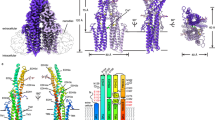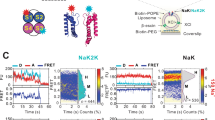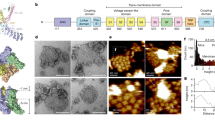Abstract
The difficulty of obtaining high-resolution structures of integral membrane proteins has been a frustrating barrier to understanding the membrane-based functions of living cells. The mere handful of such structures stands out in dismal contrast to the cornucopia of water-soluble proteins comprehensible at the atomic level. Nevertheless, crystallographically tractable preparations of aqueous domains of membrane proteins have provided molecular insight into phenomena as varied as chemotaxis, immune cell responses to antigens, viral infectivity and cellular synthesis of ATP. Recently, the first structural glimpse of a neuronal ion channel was reported — the T1, or 'tetramerization,' domain of a Shaker-type voltage-gated K+ channel at 1.6 Å resolution. The isolated domain associates into a water-soluble four-fold symmetric homotetramer. This structure prompted the novel, provocative proposal that the T1 domain is an essential component of the ion permeation pathway, forming a previously unsuspected ion-coordinating constriction on the cytoplasmic side of the channel and acting as the receptor for the pore-blocking 'ball and chain' inactivation peptide. It has also been commonly conjectured that the T1 domain is required for tetramerization in the channel maturation process. By studying the detailed properties of Shaker K+ channels in which the T1 domain is deleted, we show all these proposals to be invalid. The structure of the T1 domain expressed in isolation is therefore unlikely to mirror in detail its structure when attached to the ion-conducting channel.
This is a preview of subscription content, access via your institution
Access options
Subscribe to this journal
Receive 12 print issues and online access
$189.00 per year
only $15.75 per issue
Buy this article
- Purchase on Springer Link
- Instant access to full article PDF
Prices may be subject to local taxes which are calculated during checkout




Similar content being viewed by others
References
Li, M., Jan, Y.N. & Jan, L.Y. Science 257, 1225–1230 (1992).
Shen, N.V. & Pfaffinger, P.J. Neuron 14, 625–633 (1995).
Sewing, S., Roeper, J. & Pongs, O. Neuron 16, 455–463. (1996).
Kreusch, A., Pfaffinger, P.J., Stevens, C.F. & Choe, S. Nature 392, 945–948 (1998).
Bixby, K.A. et al. Nature Struct. Biol. 6, 38–43 (1999).
Yellen, G. Q. Rev. Biophys. 31, 239–295 (1998).
Isacoff, E.Y., Jan, Y.N. & Jan, L.Y. Nature 353, 86–90 (1991).
Holmgren, M., Jurman, M.E. & Yellen, G. J. Gen. Physiol. 108, 195–206 (1996).
Sanguinetti, M.C. et al. Nature 384, 80–83 (1996).
Heginbotham, L. & MacKinnon, R. Neuron 8, 483–491 (1992).
Goldstein, S.A.N., Pheasant, D.J. & Miller, C. Neuron 12, 1377–1388 (1994).
Zagotta, W.N., Hoshi, T. & Aldrich, R.W. Science 250, 568–571 (1990).
Murrell-Lagnado, R.D. & Aldrich, R.W. J. Gen. Physiol. 102, 977–1003 (1993).
Baukrowitz, T. & Yellen, G. Science 271, 653–656 (1996).
Zagotta, W.N. & Aldrich, R.W. J. Gen. Physiol. 95, 29–60 (1990).
Demo, S.D. & Yellen, G. Neuron 7, 743–753 (1991).
VanDongen, A.M.J., Frech, G.C., Drewe, J.A., Joho, R.H. & Brown, A.M. Neuron 5, 433–443 (1990).
Tu, L., Santarelli, V. & Deutsch C. Biophys. J. 68, 147–156 (1995).
Lee, T.E., Philipson, L.H. & Nelson, D.J. J. Membr. Biol. 151, 225–235. (1996).
Shen, N.V., Chen, X., Boyer, M.M. & Pfaffinger, P.J. Neuron 11, 67–76 (1993).
Schulteis, C.T., Nagaya N. & Papazian D.M. J. Biol. Chem. 273, 26210–26217 (1998).
Papazian, D.M. Neuron 23, 7–10 (1999).
Isacoff, E.Y., Jan, Y.N. & Jan, L.Y. Nature 345, 530–534 (1990).
Lopez, G.A., Jan, Y.N. & Jan, L.Y. Nature 367, 179–82 (1994).
Doyle, D.A. et al. Science 280, 69–77 (1998).
Johnstone, D.B., Wei, A., Butler, A., Salkoff, L. & Thomas, J.H. Neuron 19, 151–164 (1997).
Cachero, T.G., Morielli, A.D. & Peralta, E.G. Cell 93, 1077–1085 (1998).
Liu, Y., Holmgren, M., Jurman, M.E. & Yellen, G. Neuron 19, 175–184 (1997).
Rudy, B. & Iverson, L.E. Methods Enzymol. 207, 225–345 (1992).
Acknowledgements
We thank G. Yellen for providing inactivation peptides. This work was supported by a grant from the National Institutes of Health.
Author information
Authors and Affiliations
Corresponding author
Rights and permissions
About this article
Cite this article
Kobertz, W., Miller, C. K+ channels lacking the 'tetramerization' domain: implications for pore structure. Nat Struct Mol Biol 6, 1122–1125 (1999). https://doi.org/10.1038/70061
Received:
Accepted:
Issue Date:
DOI: https://doi.org/10.1038/70061
This article is cited by
-
Effective pore size and radius of capture for K+ ions in K-channels
Scientific Reports (2016)
-
The Domain and Conformational Organization in Potassium Voltage-Gated Ion Channels
Journal of Neuroimmune Pharmacology (2009)
-
Homo- and heteromeric assembly of TRP channel subunits
Pflügers Archiv - European Journal of Physiology (2005)



